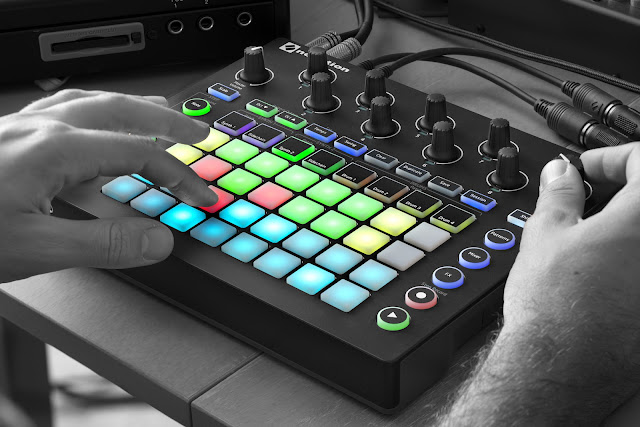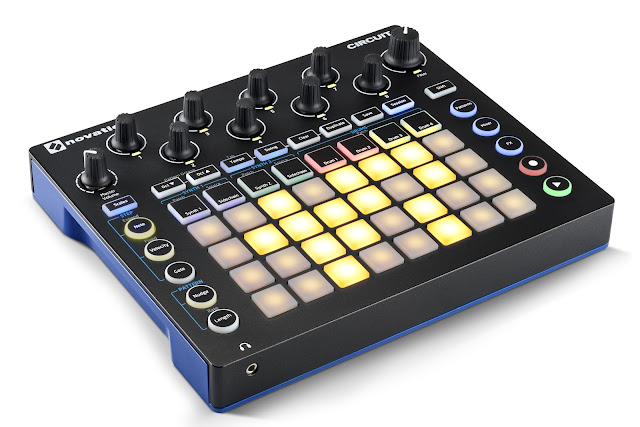You saw the
teaser pics here. The following is the official press release:
"Pittsburgh Modular makes modular effects pedals dream come true at Musikmesse 2015
PITTSBURGH, PA, USA: modern, fully-patchable, modular synthesizers and accessories manufacturer Pittsburgh Modular is proud to launch its Patch Box line of modular effects pedals — redefining both modular synthesis and the venerable stomp box by creating unique patchable effects units for guitarists and keyboardists — at Musikmesse 2015, January 15-18 in Frankfurt, Germany...
In a seismic shift in the definition of what a modular synthesizer can be, Pittsburgh Modular’s Patch Box redefines modular synthesis around the venerable stomp box by creating a monster performance device for guitarists and keyboardists alike — a patchable, modular system designed to handle anything. As a playground for unrestricted creativity, the Patch Box is a fully-patchable, customisable performance pedal enclosure. Its open architecture allows users to create unique effects unattainable with standard, fixed-signal path guitar effects. The Patch Box is not just another empty Eurorack case, however. Rather it can be packed to the gills with the functionality of (up to) five highly-tuned modules integrated into a heavy-duty steel enclosure that’s as road-ready as it is ready to use.
To protect the tone of user instruments, thoughtfully the Patch Box features a true BYPASS and a unique preamp with extremely high headroom in addition to a pair of fully-buffered outputs. Custom-engineered soft-limiting circuitry built into the preamp adds character without unwanted noise at higher gain settings. Said preamp has dual, buffered outputs to allow for complex signal routing, but for patching a single modulation or audio source into two destinations, the patchable signal splitter is a perfect solution. Also known as a MULTIPLE, the signal splitter has one input and two outputs, allowing any signal to be routed to two destinations.
Dual, assignable expression pedal INPUTS allow the Patch Box to easily integrate third-party expression pedals anywhere into the signal path to allow for realtime foot control of any voltage-controllable parameter or split the signal from the foot controller to control two parameters at once. Dual, assignable A/B foot switches — SWITCH 1 and SWITCH 2 — expand signal routing options. Perfect for use as on/off switches or to flip between two signals, the foot switches can be patched up to enable/disable individual modules or route audio and control voltages. Try patching a modulation source, such as an LFO (Low Frequency Oscillator) or external expression pedal, through the foot switch to enable or disable the modulation while playing. Patch the outputs of two effects into one of the foot switches to bounce between effects. With two independent, patchable foot switches to play with, there are countless options for realtime signal routing. The last stage of the Patch Box signal path is a master OUTPUT level control. Adjust the output signal level to connect with a wide range of devices.
Furthering flexibility, the Patch Box is available as an empty case, ready and waiting for user-customisation, courtesy of an ever-increasing selection of Pittsburgh Modular, Dwarfcraft Devices, or other compatible Eurorack-format modules. Meanwhile, the Patch Box is also available in a number of preconfigured so-called Complete and Core effects systems that highlight the wide range of Pittsburgh Modular and Dwarfcraft Devices effects modules — from stunning filters to character-rich analogue delays, sweeping phase shifters to nasty distortion, and much more besides... all are available to interact with and manipulate in entirely new ways! Why don’t we take a closer look at what’s on offer?
Being billed as “A Modular Exploration of Time and Space,” Time Box Complete comes complete with a Patch Box enclosure, Analog Replicator (wide-range analogue delay module), Reverb (voltage-controlled digital reverb module), Lopass Gate (integrated lowpass filter, VCA, and lowpass gate module), LFO2 (dual modulation source module), and Multiple (dual passive signal splitter), plus a 12-pack of patch cables from premier Eurorack modular synthesizer accessory specialist Nazca Audio. Alternatively, Time Box Core comprises Patch Box-housed Analog Replicator and LFO2 modules, plus a six-pack of Nazca Audio patch cables.
Next up, Filter Box Complete makes modular filtering and signal-crushing downsampling a flexible musical experience, thanks to a Patch Box-housed Filter (multimode state variable filter module), Lopass Gate, Crush (analogue downsampling module), Follow (envelope follower module), LFO2, and Multiple, plus a 12-pack of Nazca Audio patch cables. ‘Downsizing’ somewhat, Filter Box Core offers filter sweeps courtesy of a Patch Box-housed Filter, Follow, and LFO2 modules, plus a six-pack of Nazca Audio patch cables.
Phase Box Complete comes complete with a Patch Box enclosure preconfigured with a Phase Shifter (16-stage analogue phase shifter module), Lopass Gate, LFO2, and Multiple, plus a 12-pack of Nazca Audio patch cables. Phase Box Core makes massive liquid simplicity reality with Patch Box- housed Phase Shifter and LFO2 modules, plus a six-pack of Nazca Audio patch cables.
A collaboration with Eau Claire, WI, USA-based handmade effects pedals and synthesizers specialist Dwarfcraft Devices, Dwarf Box Complete celebrates this partner company’s expertise in sonic destruction by partnering up their Big Distortion Sound Machine (parallel distortion module with two distinctly different fuzz flavours) with Pittsburgh Modular’s Filter, Chain Reactor (quadraphonic, voltage-influenced chaotic waveform generator), and Toolbox (multi-purpose slew, noise, sample & hold, and inverter) modules in a Patch Box enclosure, plus a 12-pack of Nazca Audio patch cables. Coming full circle, those favouring a more streamlined approach to a destructive palette could consider the Dwarf Box Core, comprising Patch Box- housed Big Distortion Sound Machine and LFO2 modules, plus a six-pack of Nazca Audio patch cables.
There it is, then. Nine new products, no less — Patch Box enclosure, available without any modules, and two sets of four preconfigured systems, each offered as a Complete system, full of modules, or as a Core system, partially filled with room for additional modules. Pittsburgh Audio has truly made the dream of modular effects pedals come true. They will all be being demoed and displayed in Hall 5.1, Stand C53 at Musikmesse 2015, April 15-18 in Frankfurt, Germany. Come check them out!
The Patch Box modular Eurorack performance pedal enclosure will be available to purchase from Pittsburgh Audio’s authorised dealer network in May 2015 at a suggested retail price of $349.00 USD.
Time Box Complete will be available in June 2015 at a suggested retail price of $1,199.00 USD; Time Box Core will be available in May 2015 at a suggested retail price of $779.00 USD.
Filter Box Complete will be available in June 2015 at a suggested retail price of $1,149.00 USD; Filter Box Core will be available in May 2015 at a suggested retail price of $739.00 USD.
Phase Box Complete will be available in June 2015 at a suggested retail price of $1,029.00 USD; Phase Box Core will be available in May 2015 at a suggested retail price of $799.00 USD.
Dwarf Box Complete will be available in June 2015 at a suggested retail price of $1,199.00 USD; Dwarf Box Core will be available in May 2015 at a suggested retail price of $689.00 USD.
For more detailed information, please visit the Patch Box product webpage from here:
http://www.pittsburghmodular.com"






































































